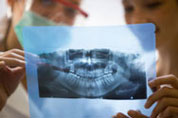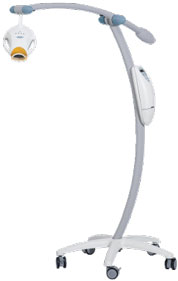Services
Our dental studio uses the latest ultrasonic devise for the removal of plaque and debris from teeth. It is more effective and considerably more pleasant than the old metal scraper method. However, if you do notice any discomfort we can provide a localized anesthetic.
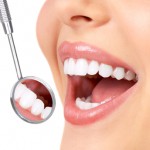 Plaque needs to be properly removed because bacteria can settle in and cause the inflammation of the gums and foul breath. Using Gracey spoons plaque can be removed even under the gum.
Plaque needs to be properly removed because bacteria can settle in and cause the inflammation of the gums and foul breath. Using Gracey spoons plaque can be removed even under the gum.
The final stage in our cleaning process is polishing. Using a special device, tiny pieces of pearl are blown on to the teeth which remove stains caused by smoking, coffee or food. After that the teeth are covered with a polishing paste and polished with a rubber boot (a rotating piece of rubber).
The precondition for any successful dental procedure is the proper dental hygiene. This does not only concern the hygiene of dental surfaces but also that of the gum and mouth cavity.
Many people think that cleaning teeth equals brushing teeth. It would be great if this were true because then everybody could do it themselves. Unfortunately bits of food get stuck in places between the teeth and under them that cannot be removed with a toothbrush. Actually there is no such denture, however thoroughly it has been cleaned, that a dentist could not clean further. Of course this doesn’t mean that we should go to the dentist in the morning at noon and in the evening to have our teeth cleaned. But at times we have to go to our dentist so they can call attention to the parts that need more attention or to correct our technique for cleaning those spots.
It is recommended you have this type of professional cleaning ever four or five months.
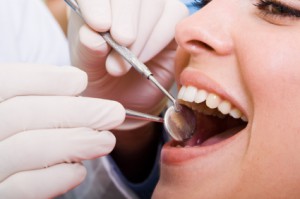 Both fillings and inlays are treatments for the formation of cavities on the surface of tooth and beneath. Specific treatments vary based on the size of the cavities. So-called superficial lezio can be treated with ozone therapy without drilling. Cavities on the cutting edge or on the neighbouring surfaces of teeth, in the glaze or in the dentin are filled. If the cavity is large or it occurs in several places, or if it involves a break in some part of the tooth, inlays are recommended. The inlay is a kind of filling which substitutes the missing dental tissue, giving back the original function and shape to the tooth. This type of filling is not only aesthetic but also lasting.
Both fillings and inlays are treatments for the formation of cavities on the surface of tooth and beneath. Specific treatments vary based on the size of the cavities. So-called superficial lezio can be treated with ozone therapy without drilling. Cavities on the cutting edge or on the neighbouring surfaces of teeth, in the glaze or in the dentin are filled. If the cavity is large or it occurs in several places, or if it involves a break in some part of the tooth, inlays are recommended. The inlay is a kind of filling which substitutes the missing dental tissue, giving back the original function and shape to the tooth. This type of filling is not only aesthetic but also lasting.
The inlays that consist of strengthened composite (belle glass, Gradia) and ceramic offer suitable solution for 8-12 years. Any tone can be achieved and thus we can match the colour of the original teeth precisely.
 The aesthetic denture should not just be clean and shiny but also light. In order to achieve this the fillings must be matched to the colour of the original teeth. Many believe that the replacement of older filling material is important because the amalgam filling used in the past presents health hazards. Some metal amalgams contain 3% quicksilver, which is considered dangerous because of the dense veins of the mouth cavity everything is absorbed very quickly. There are many materials we can use to replace amalgam:
The aesthetic denture should not just be clean and shiny but also light. In order to achieve this the fillings must be matched to the colour of the original teeth. Many believe that the replacement of older filling material is important because the amalgam filling used in the past presents health hazards. Some metal amalgams contain 3% quicksilver, which is considered dangerous because of the dense veins of the mouth cavity everything is absorbed very quickly. There are many materials we can use to replace amalgam:
Belle glass: a kind of plastic strengthened with glass fiber. It can be used to make inlays side crowns traditional short bridges and inlay anchored one-member short bridges. Because is not as hard as other materials it is not used to build front crowns.
Gradia: a similar material to belle glass with similar usage.
Traditional ceramic: used mostly for inlays and solo crowns.
Pressed ceramics/ IPS Empress: used to make crowns, inlays and short bridges. The latter is made by putting ceramics onto a previously made hard frame.
Burnt ceramics: used for everything that traditional ceramic is used for, but better than the traditional metal based ceramics because it does not cause allergy and its colour is not greyish but golden yellow. Gold is more natural and closes better at the edges of replacement prostheses.
Ceramics burnt on galvanized gold: the stub is covered with a thin gold layer which results accurate closure at the edges. It is concealed with ceramics. Ceramics inlays burnt on galvanized gold will have a very thin gold edge at the closing line so that it provides perfect sealing.
Fixed replacements made with Computer Aided Design and Computer Aided Manufacturing: The dentist prepares the teeth and takes a cast which is sent to the dental technician. The technician designs the frame of the replacement on a computer and then the result is sent to Germany or Sweden. There, based on the given data the frame is cut from a zirconium dioxide block by a computer. The frame is then shipped to the technician who sends it to the dentist for a trial. If it is suitable, the technician builds the complete tooth or replacement from porcelain, which the dentist later puts in. Its advantage is the good sealant and flexibility. Its transparency is excellent and the frame can be made from different colours.
 The roots are those parts of the teeth which are located in the jaw canal in which one or two canals run along. In this canal are the nerves and the veins which supply blood to the tooth. The root canal can get infected when tooth decay from the crowns reaches the root. When this happens, the pulp either gets inflamed or slowly dies away. In the former case we become sensitive to cold in the latter to hot. If the dental canal gets injured because of tooth decay or fracture the treatment of the root cannot be avoided because in the process of inflammation the bacteria start degrading the tissues in the canal, causing severe pain. The treatment of the roots is actually the complete cleaning of the canals from tissue fragments, all kinds of bacteria and infected tissues. This is followed by the hermetic sealing of the roots. They have to be cleaned and the infected dental tissue has to be removed. After that the root canal is disinfected and filled with filling materials. A successful filling seals the canal hermetically from a free side and the filling fills up the canal completely. After 1 or 2 weeks the pain will be gone.
The roots are those parts of the teeth which are located in the jaw canal in which one or two canals run along. In this canal are the nerves and the veins which supply blood to the tooth. The root canal can get infected when tooth decay from the crowns reaches the root. When this happens, the pulp either gets inflamed or slowly dies away. In the former case we become sensitive to cold in the latter to hot. If the dental canal gets injured because of tooth decay or fracture the treatment of the root cannot be avoided because in the process of inflammation the bacteria start degrading the tissues in the canal, causing severe pain. The treatment of the roots is actually the complete cleaning of the canals from tissue fragments, all kinds of bacteria and infected tissues. This is followed by the hermetic sealing of the roots. They have to be cleaned and the infected dental tissue has to be removed. After that the root canal is disinfected and filled with filling materials. A successful filling seals the canal hermetically from a free side and the filling fills up the canal completely. After 1 or 2 weeks the pain will be gone.
The crown is a replacement which covers the complete surface of the tooth. It is needed when so little dental tissue remains due to tooth decay that there is little left to chew with. In some special cases when there is a missing tooth the crown is fixed on to two neighbouring teeth. This is called a bridge. Crowns usually reach the edge of the gum and are fixed to a so-called shoulder which is formed on the teeth by the dentist. Installing a crown or a bridge will require several visits to the studio.
Aesthetic covers are usually built on the lip-side surfaces of the teeth. Generally it is very thin. It is mostly made to cover something (too large a gap between teeth, dark or misshaped tooth). To put this cover on the dentist needs to remove half a millimeter of dental tissue from the outer most layer of the tooth. The cover itself can be made by a dental technician too. It can be made of ceramics or in the case of rear teeth it can be acrylate-based material. It is fixed by using special glues and last for several years.
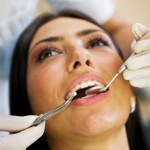 Rings, tattoos and piercing are popular with young people. Some prefer the unique look of tooth jewelry. The tooth jewel is usually fixed to the upper incisor with a special dental glue. The tooth does not need to be prepared or drilled and when we get bored with the tooth jewelry it can be removed without leaving stains or causing damage. They can be made in gold, silver platinum or different combinations of precious metals and jewels in various shapes. It is usually left on the tooth for months and then changed for a new one. It does not fall out while eating or cleaning teeth.
Rings, tattoos and piercing are popular with young people. Some prefer the unique look of tooth jewelry. The tooth jewel is usually fixed to the upper incisor with a special dental glue. The tooth does not need to be prepared or drilled and when we get bored with the tooth jewelry it can be removed without leaving stains or causing damage. They can be made in gold, silver platinum or different combinations of precious metals and jewels in various shapes. It is usually left on the tooth for months and then changed for a new one. It does not fall out while eating or cleaning teeth.
 The child’s first permanent tooth appears under the baby teeth around the age of 6. When it appears its development phase has not yet finished, so the fissure system between the teeth have not closed either. This narrow fissure is very difficult to clean. Considering the fact that this is the most used tooth, tooth decay tends to appear here first. That is why the fissure systems of the molars are worth sealing within half a year after permanent teeth appear. The dentist cleans the surface of the tooth thoroughly then kills the bacterium flora with ozone. Then the tooth is pretreated and liquid filler is sprayed on the fissure. This material hardens when exposed to light. The treatment is absolutely painless. The filler remains on the tooth for several years, but it should be checked every sixth months.
The child’s first permanent tooth appears under the baby teeth around the age of 6. When it appears its development phase has not yet finished, so the fissure system between the teeth have not closed either. This narrow fissure is very difficult to clean. Considering the fact that this is the most used tooth, tooth decay tends to appear here first. That is why the fissure systems of the molars are worth sealing within half a year after permanent teeth appear. The dentist cleans the surface of the tooth thoroughly then kills the bacterium flora with ozone. Then the tooth is pretreated and liquid filler is sprayed on the fissure. This material hardens when exposed to light. The treatment is absolutely painless. The filler remains on the tooth for several years, but it should be checked every sixth months.


